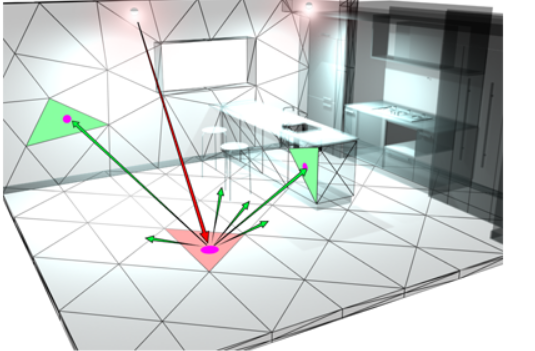Images
- Continuing with chapter 1
- He states that images created in a graphics system are synthetic
- We will do an overview of the "graphics model"
- The system is composed of Objects and Viewers
- Humans:
- You are the viewer
- You are looking at real physical objects.
- Light from the objects
- Passes through your cornea and lens
- And strikes your retina where an image is formed.
- This is an upside down two dimensional image.
- And it is discrete, estimated at 576 megapixels.
- Your brain takes the two images, slightly offset and "constructs" a 3d image.
- By the way, the number of colors you can see is estimated to be around 10 million.
- Look at the Color vision table on Wikipedia.
- For a camera
- The model is very close to the same.
- But the biological items are replace
- And the image is formed on film or a sensor
- CCD: Charge-coupled device, or a CMOS based system
- Thank monitor/framebuffer in reverse
- In a graphics system
- Objects are specified as
- Primitives:
- What to draw
- Usually a vertex or a set of vertexes
- A "type" for the primitive, or how to connect the vertexes
- Attributes:
- How to draw it
- Colors, widths, ...
- The viewer is somewhat akin to a photographic plate or CCD
- It has a position in space
- It has a resolution
- It has a range of colors supported.
- The trick is to fill in the right pixels for the primitives defined.
- We will spend quite a bit of time discussing how to do this.
- In the end, almost everything we deal with will be triangles specified as vertices.
- Light
- We tend to simplify light in computer graphics systems.
- Think of it as an RGB value.
- Think of it as a point source
- A single infinately small element
- Emitting "light" in all directions.
- We control the color, intensity and other parameters
- Light is tough and an entire chapter later on.
- Image Models
- Light strikes an object
- Based on the (physical properities/attributes) of the object, light is
- Absorbed (stealth object, story over)
- Reflected (bounces off where the angle of incidence and algle of reflection are equal)
- Transmitted (acording to Snell's Law
- Or all three.
- Ray Casting
- There is a light source emitting light rays.
- Follow all of the rays to see what light strikes the viewer
- Computationally impossible.
- But Radiosity is an attempt.
- Objects are divided into a number of patches.
- Connections between patches, known as view factors, are described mathematically.
- Every patch interacts with every other patch.
- These are used to compute the light that is transfered from one patch to anohter.
- The process is applied iteratively.
- Initially only the light sources have any "light"
- Later others get "reflected" illumination
-

- Great for diffues light, soft glow.
- Good for any position in the "area"
- Ray Tracing
- From each pixel in the viewer
- Trace a ray out along the viewing direction.
- Each ray will either
- Strike a light source
- This will give us a color for the pixel (or at least a start)
- The process ends (sort of)
- Strike an object (see above)
- Continue the process, but accumulate results of traced ray(s).
- Go to infinity, so no color from this ray.
- The ray has "too many iterations"
-
 (An image I stole from online)
(An image I stole from online)
- Great for light and shadows, shiny, translucient ...
- Only good for one position.
- Neither of these tehcniques are acceptable (yet) for real time graphics.

 (An image I stole from online)
(An image I stole from online)